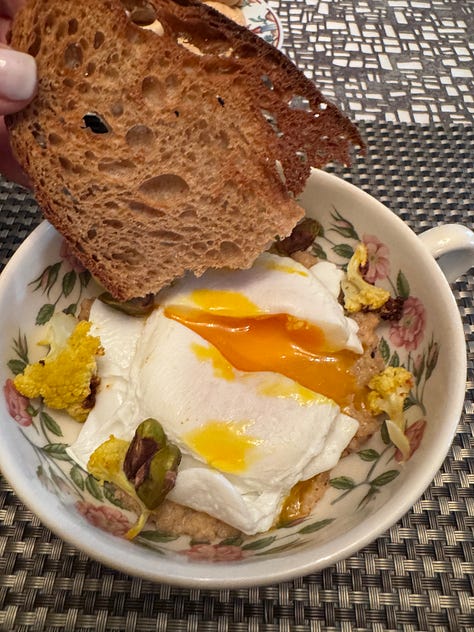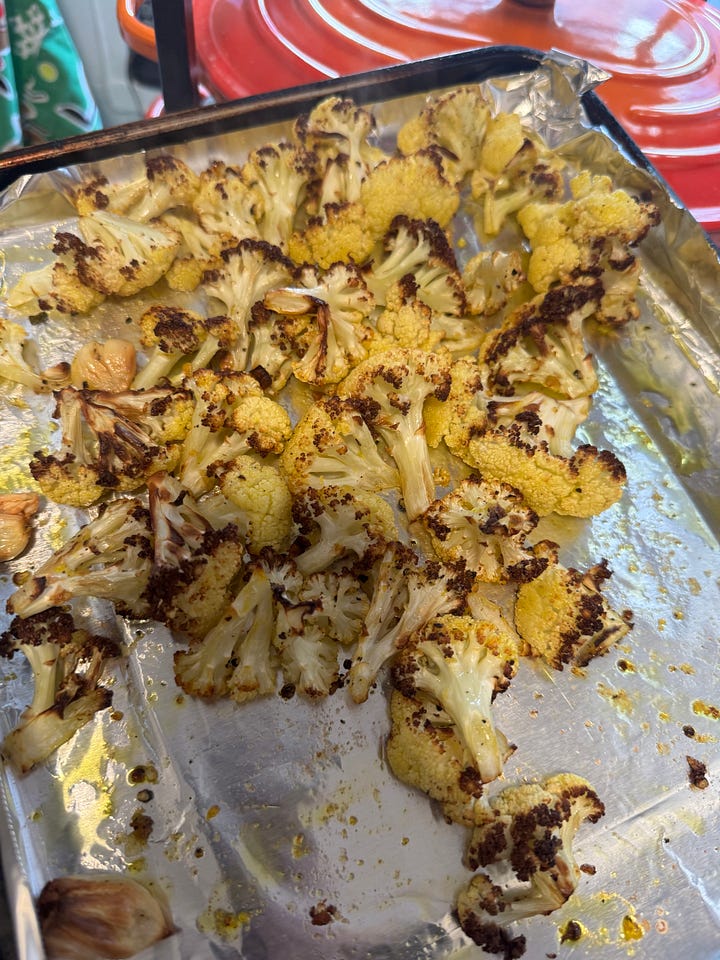Nourishing the Mind and Body: A Chef’s Journey into Ayurvedic Cooking
How to Start Cooking with Ayurvedic Principles Without Overhauling Your Diet
Namaste and Greetings!
Welcome to my newsletter, where I explore the wisdom of Ayurveda and share practical ways to bring balance, nourishment, and ease into your daily life. Whether you're here to learn, try something new, or simply find inspiration, I’m so glad you’ve joined me.

This post is late. I’ve set a schedule for myself, and well... it's late!
The truth is, I’ve been hesitant to publish this post because it’s about food. And food is a big part of my identity—both professional and personal. You see, I’ve been a professional chef since 1998 (yeah, I’m that old).
Over the years, I’ve worn a few other hats. I worked as a behavior modification specialist with young children facing developmental challenges and now spend a few days a week working with older individuals experiencing cognitive decline. Yet, through all of this, I still see myself as a chef first and foremost.
When I began studying Ayurveda, I naturally assumed I would specialize in Ayurvedic cooking. I thought, “With my cooking background, learning these new principles will be a breeze.”
It hasn’t been. Far from it.
I’ve struggled to become what I’d like to think of as an expert in this area. Through reflection and letting go of perfectionism, I’ve come to an important realization: while I may not yet be the expert I aspire to be, I have a wealth of experience and knowledge to share. As both a chef and a student of Ayurveda, I can offer insights into Ayurvedic cooking principles that can be approachable and impactful—without requiring a complete overhaul of anyone’s eating habits.
Let’s Begin

What is Ayurvedic Cooking?
Ayurvedic cooking is part of a 5,000-year-old system rooted in the idea that food is more than just fuel—it’s energy. It’s a way of thinking about food that connects us to nature and encourages us to observe how what we eat impacts how we feel.
At its core, Ayurvedic cooking is about balance and mindfulness. It’s not a rigid set of rules or recipes, but rather a thoughtful approach to eating that considers the qualities of the food we consume, the environment we’re in, and the individual needs of our body.
As I explored these principles, one concept completely shifted my perspective. And that is prana. It’s a word you’ll hear often in Ayurveda, and it refers to the life force or vitality present in everything around us—including our food. When we eat food with high prana, it feels alive and nourishing, and our body recognizes and uses it for the nutrients, effortlessly.
A Note on Vegetarianism
Ayurvedic food isn’t necessarily vegetarian. While there’s a strong emphasis on plant-based foods because of their ease of digestion and calming effects, Ayurveda doesn’t forbid non-vegetarian options. The goal is to choose foods that support balance and well-being for your unique body and mind. I’m not here to create barriers or make anyone feel guilty for their choices. Starting small always feels more manageable, and that’s the best place to begin.
Understanding Prana: The Life Force in Food
Prana is the energy present in all living things. In food, it's the vitality that nourishes not just our body, but also our mind.
Here’s a little exercise. Picture a freshly picked apple, vibrant and crisp. You bite into it, and it bursts with flavor and juiciness. That apple is packed with prana or life. Now compare it to an apple-flavored snack bar that’s been sitting on a shelf since, oh, maybe the Jurassic era. The difference is obvious. The snack bar tastes fine (sort of), but it feels flat—lifeless, like it’s just going through the motions. That’s because it has little to no prana left.
See where I’m going with this? Foods that are fresh and close to their natural state—like fruits, vegetables, whole grains, nuts, and seeds—are bursting with life. On the other hand, overly processed or food reheated multiple times have almost no prana left.
But here’s the thing: We’re not here to judge your snack bar habits. I’m also not saying you need to raid a farmer’s market every day or become a prana-obsessed perfectionist. This is about awareness.
So, here’s your homework (don’t worry, it’s easy). The next time you eat, take a look at what’s on your plate and see which foods are in their simplest form (closest to nature) and which foods are highly processed. Does the food make you feel alive and energized, or does it leave you feeling sluggish and heavy? No pressure, no guilt—just observe.
Start paying attention to how different foods make you feel, both physically and emotionally. You might be surprised by what you notice.
Simple, right? Give it a try. Let me know how it goes.

Spices: Small Ingredients, Big Impact
One cannot talk about Ayurvedic principles without mentioning spices.
In Ayurvedic cooking, spices are like little packets of personality. They can be warm, earthy, bright, or soothing, and they do so much more than just add flavor. Think of them as your kitchen’s quiet multitaskers—they enhance taste, help with digestion, and even bring balance to your meals.
And don’t worry, you don’t need a pantry full of spices to get started. In fact, you probably already have some Ayurvedic staples without realizing it. Cumin, coriander, fennel, and turmeric are all simple, versatile spices that can elevate a dish without making it taste “spicy.” They’re subtle, aromatic, and easy to sprinkle into whatever you’re already cooking.
For example, adding a pinch of turmeric to a soup or stew or sprinkling toasted cumin powder on roasted vegetables can bring a touch of warmth and depth without overwhelming the dish. Spices are about enhancing—not taking over.
Start small. Pick one or two spices to experiment with. You might be surprised at how a little dash can transform your meal into something that feels fresh and new.
I will talk about specific spices and their health benefits in upcoming posts.
A Brunch Experiment: Putting Ayurvedic Principles to the Test
Let me show you how I made a brunch following Ayurvedic principles. It was a thought experiment of sorts for me. I didn’t want my friends to know that there was any Ayurveda involved until the end.





I spiced seasonal, prana-rich cauliflower with turmeric, fennel seeds, garlic, salt, and cayenne pepper. For oil, I used mustard oil, a staple in northern India during the winter. It has warming properties and a sharp, peppery flavor that I love. I roasted the cauliflower until caramelized and soft, then blended it with vegetable stock into a rich, smoky puree using an immersion blender.
Since it was brunch, I poached a few eggs and toasted some pistachios—simply because that’s what I had on hand. Pine nuts or walnuts would work just as well.
(Please forgive the audio - I was unable to remove it) I wanted to show you how the soft egg yolk will mix with the puree and all the flavors will come together.When my friends arrived, I warmed the bowls, spread the cauliflower puree at the base, and topped it with one or two poached eggs. I garnished the dish with roasted cauliflower florets, a drizzle of mustard oil, and the toasted pistachios.
Dare I say, it was a hit! Everyone enjoyed it.
Ayurvedic Principles at Play
I used ingredients that were minimally processed, close to their natural form.
I incorporated spices to aid digestion and elevate the flavor.
The food was freshly prepared, preserving its prana.Even as a beginner in Ayurvedic cooking, it’s possible to keep things simple and make minor adjustments that enhance both taste and nourishment. Small steps can make a big impact on how your body receives and uses nutrients.
Finally,
If you haven’t subscribed yet, now’s the perfect time to explore all the Ayurvedic insights coming in 2025! Whether you’re a free or paid subscriber, your presence means the world to me.
Thank you for being part of this journey.
Until next time,






I would have loved to be at that brunch!!😋
By the way, on my way to fridge to get a fresh apple.